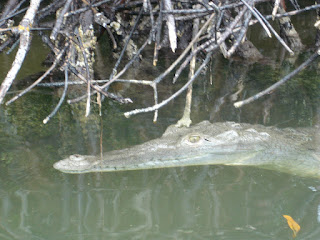After a fairly uneventful drive along a narrow road with heavy rain and trucks coming from the opposite direction, we arrived at the frankly aesthetically challenged village of Rio Lagartos, where we were immediately spotted by a bicycle-riding tourist-snatcher. This advance person took us (follow me!) to the dock where the arrangements were made to take the bird-watching tour; we paid 700 pesos for the 2 hour tour.
The rain had since mostly disappeared except for a light occasional drizzle and when we expressed some trepidation about riding in the boat with the rain, the guide informed us that he had already equipped the tour with some 'nailoms'. From the english word 'nylon' these turned out to be garbage bags... he informed us that we would be comfortable because it was not raining that hard and besides, the nailom we would be using was large enough to adequately protect us from the moisture. When our dubious expressions convinced him that he would have to be a little more convincing, he mentioned that he could get some 'impermeables' which are, in fact, raincoats. "Should I get them?" he asked. "Well, yes." I answered. And dressed in bright yellow rain coats (mine said CFE) we were off.
The drizzle was a little too persistent and one of the people in the party insisted on having the top put on the boat. It turns out the top is a canvas material, not particularly waterproof but it did make a little difference.
 The first stop was a few minutes into the trip, when we were shown a crocodile. Quite a sight! Then the rest of the trip was quite entertaining, if you are into birds; all kinds were spotted along the way. To get to the highlight of the two-hour trip, the flamingoes, you have to go through a very shallow part which seems to take forever and will lull you to sleep if you can get comfortable enough. The motor is turned off, and the guide will pole the boat around trying to get close enough to observe the bright pink birds up close, without disturbing them into taking flight.
The first stop was a few minutes into the trip, when we were shown a crocodile. Quite a sight! Then the rest of the trip was quite entertaining, if you are into birds; all kinds were spotted along the way. To get to the highlight of the two-hour trip, the flamingoes, you have to go through a very shallow part which seems to take forever and will lull you to sleep if you can get comfortable enough. The motor is turned off, and the guide will pole the boat around trying to get close enough to observe the bright pink birds up close, without disturbing them into taking flight. On the way back, a stop to see where the Salinera de Yucatan makes salt. You can float in the salty water, a rust-red color, filled with extremely salty water treated with some chemicals, and it has amazing buoyancy qualities, if you don't mind the mystery chemicals that the water contains. This is followed by a beauty treatment, where the guide makes a hole in the mucky sand to extract the fine white clay mud which he proceeds to smear on your face and body, if you so desire.
On the way back, a stop to see where the Salinera de Yucatan makes salt. You can float in the salty water, a rust-red color, filled with extremely salty water treated with some chemicals, and it has amazing buoyancy qualities, if you don't mind the mystery chemicals that the water contains. This is followed by a beauty treatment, where the guide makes a hole in the mucky sand to extract the fine white clay mud which he proceeds to smear on your face and body, if you so desire. And so, covered in your exfoliating scrub, you head back to the dock, stopping along the way to jump in the water to rinse off. If you are lucky, as we were, the guide will at that point show you a crocodile swimming close by.
Back at the dock, we looked for a spot to have lunch but there isn't much in the way of tourism infrastructure to speak of; in fact, the town is quite ugly and there is garbage everywhere, so we decided to head over to San Felipe, a 10 minute drive away.
- to be continued -



